Scientific Name: Yucca baccata and the Yucca species
Common Names: banana yucca, Spanish dagger
Plant Family: Asparagaceae – asparagus (recently in the Agavaceae family, which is now the sub-family Agavoideae of the Asparagaceae plant family)
Article by Janice Tucker
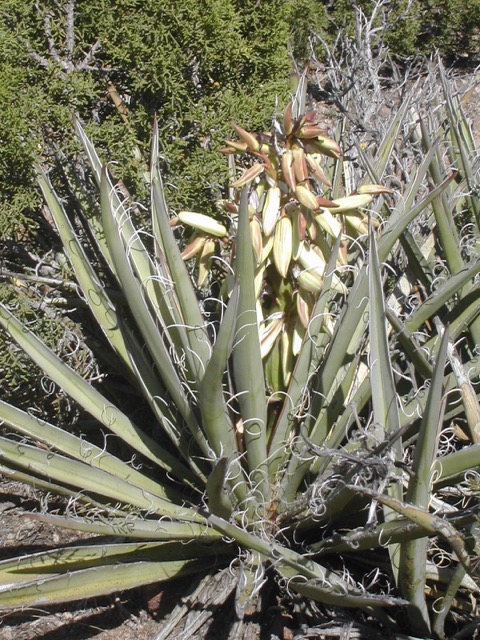
Photo credit: Carl Troy
The presence of a Yucca in a New Mexico garden honors the rich history, culture and beauty of our state. The species in the Yucca genus are among those wonderful native plants that grace our natural landscapes as well as our home gardens. Long ago travelers who made their way from Mexico toward Santa Fe described the Yucca’s lovely white flower spikes as “Lámparas de dios” – Lamps of the Lord – due to their luminescence that seemingly lit the way during their long, northward journey. Native Americans have shared numerous practical uses for this plant of unique beauty. So it should come as no surprise that in 1927, without defining a particular species, New Mexico school children chose the Yucca as the state flower.
The perennial banana yucca (Yucca baccata) is one of the most common of the 40 to 50 Yucca species. Its ability to survive unattended on rocky slopes, open spaces and along roadsides is evidence of its hardiness in high altitudes, dry climates, poor soil and dramatic temperature swings. The banana yucca’s spikes of oblong, cream-colored, purple-tipped flowers nestled in among rosettes of wide, sharply tipped, fibrous leaves portray an appealing structural contrast of softness and rigidity. As the flowers fade they leave a gift of edible fruit, which, when baked, is compared to that of a sweet potato.
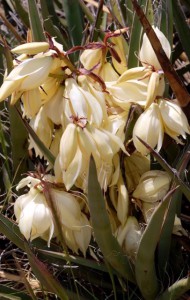
Yucca baccata bloom close up. Photo credit: Janice Tucker
Yuccas tend to tuck their petals inward during the warm daylight hours. As the sun sinks beneath the horizon the flowers begin to unfold in the cooler temperatures of the gathering dusk. The opened flowers release their seductive fragrance to waft through the night air, telegraphing a message to the female yucca moth (Tegeticula species) that they are primed for pollination. The tiny moth answers the signal and carries forward the age-old, mutually beneficial relationship between the Yucca and the yucca moth.
The female moth has two purposes in her short life: To lay her eggs and to pollinate the Yucca. She first collects pollen from the flowers’ anthers, shaping it into a lump to carry away to a flower on another plant. She instinctively knows to choose a flower when it is at the right stage for pollination. And she will not intrude if another moth has already laid eggs in a selected flower. Instead she will continue to search for an unused blossom to house her babies. After the eggs are safely deposited in the flower’s ovary, she seals the top of the stigma with the collected pollen and by doing so pollinates the Yucca. This is very important because Yuccas do not self-pollinate. The Yuccas that thrive in natural habitats depend on the yucca moth to perform that vital function.
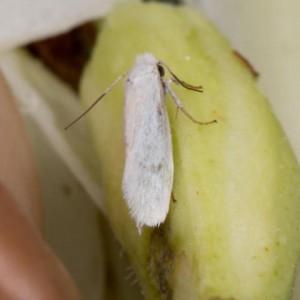
Photo credit Betsy Betros Copyright © 2014 The Bug Guide
The Yucca, having benefited from the moth’s pollination, will in turn provide both shelter and food for the moth’s offspring. Apparently the Yucca’s seed production is plentiful enough to feed both the larvae and to yield ample amounts for its own existence. What a perfect example of flora and fauna working in concert to further the continuation of their individual species. Some commercial nurseries cultivate Yuccas by hand-pollination. But nature’s fascinating method takes it a step further to ensure the existence of the yucca moth.
The banana yucca is a perfect resident in a xeric garden. Give them sun and soil that drains well. Take a cue from Mother Nature when it comes to moisture: Do not overwater. Yuccas normally bloom in early summer, followed by their unique fruit and seedpods, which remain through fall. Their leaves, which remain green year round, offer a spot of color among dormant plants during the winter months. Maintenance is minimal. Just trim unsightly foliage to make sure the plants are appropriately groomed for a home garden.
Several years ago the Yucca genus was in the lily family (Liliaceae). Taxonomists then decided it really should be placed in the agave family (Agavaceae). However, recent DNA evidence has decreed that the entire agave family should be classified as the Agavoideae sub-family in the asparagus family (Asparagaceae). Keeping up with plant names and classifications requires a strong constitution!
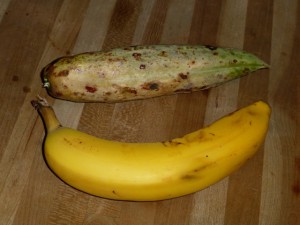
Photo credit: David Salman, waterwisegardening.com
Often the scientific plant names reveal some insight into at least one of the plant’s characteristics. But that does not apply in this case. “Yucca” is Caribbean – and actually spelled “yuca”. Yuca is a common name for Manihot esculenta, which is in the Euphorbiaceae family and the two are not even remotely related. There seemed to be some translation mix-up between Swedish and one of the many Caribbean languages back in the mid-1700’s when Carl Linnaeus dubbed the genus Yucca. But the name stuck. Now that we’ve had a few centuries to become comfortable with a Yucca spelled with two c’s, lets hope the taxonomists will leave it be. The definition of the species name baccata is, “with berry-like fruit”. The Yucca baccata does not have berry-like fruit. Its oblong fruit is green, eventually turning brown. Its resemblance to a ripe banana gives it the common name of banana yucca.
Many of the Yucca species have edible flowers and fruits but please do not consume the roots – they’re toxic. Folk medicine advocates declare it is helpful as an emetic or in treating arthritis. Soap and shampoo made from the roots are said to result in healthy skin and luxuriant, glossy tresses. And while the flowers and fruit are edible, the roots aren’t. Think about it….soap is made from the roots. You would not eat soap.
Native Americans have trod the earth in shoes woven from Yucca leaves. Ropes, cords, belts, baskets, and brooms are a few of the multiple handmade products fabricated from the Yucca leaves. A rustic needle and thread can be fashioned from shredding the leaves’ stiff fibers into thread and using the sharp tip as a needle. Yuccas are often planted side by side to form a defensive border. There is no doubt that the Yucca will be the victor with anyone who tangles with those dagger-tipped leaves. It’s called Spanish dagger for a reason.
The Yucca baccata will be a star attraction in Ojos y Manos: Eyes and Hands, the new addition to the Botanical Garden at Museum Hill. Ojos y Manos (Eyes and Hands) will celebrate the ethnobotanical value and contribution to our rich culture by providing a venue for numerous native plants and their traditional uses.
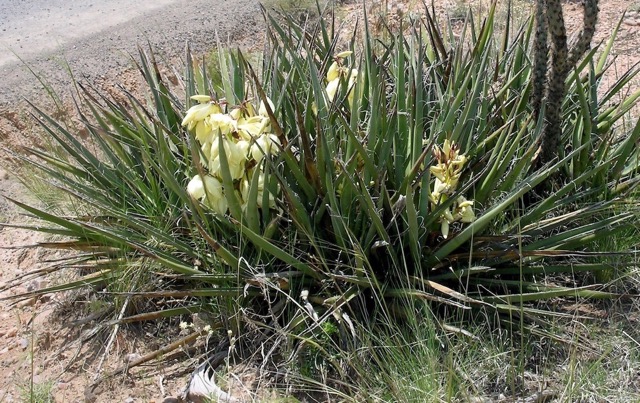
Photo credit: Janice Tucker
In her book, Healing Herbs of the Upper Rio Grande, Leonora Scott Muse Curtin wrote an eloquent tribute to the Yucca: ”I have always been grateful for the yucca, a plant without parallel in its lonely habitat of rocky slopes or arid plains, seldom blessed with rain, where it blooms in towering shafts of white-flowered beauty.” Beautiful!
Thanks to Helen Woody and Jeanne Gozigian for proofreading this article.
Sources consulted and/or cited:
Curtin, L.S. M, Healing Herbs of the Upper Rio Grande
The Bug Guide website, Betros, Betsy, Yucca Moth Photo
Lady Bird Johnson Wildflower center plant database
Moore, Michael, Medicinal Plants of the Mountain West
National Audubon Society Field Guide to Wildflowers
Phillips, Judith, New Mexico’s Gardener’s Guide
Santa Fe Botanical Garden plant database
State Symbols USA website, Yucca New Mexico State Flower
USDA Forest Service website, Plant of the Week, Banana yucca (Yucca baccata)
USDA Forest Service website, Yucca Moths (Tegeticula sp.)


